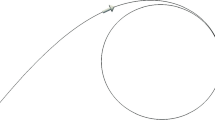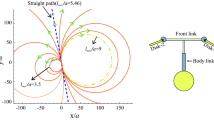Abstract
In this paper, we compare the translation efficiencies of a deformable circle that swims by means of low amplitude periodic tangential surface waves versus a rigid circle, moving in a bounded fluid domain. The swimmer is found to be much more efficient than the rigid body. We believe that this result gives some support to the active hypothesis of subcellular transport, where it is supposed that the organelle can generate by itself a propulsive flux, (by changes of form or metabolic activities) instead of just being carried by the motion of an external agent, like a molecular motor.
Similar content being viewed by others
References
Beretier-Hahn, J.: Behavior of Mitochondria in the Living Cell, Intl. Rev. Cytol. 122 (1990), 1–63.
Bereiter-Hahn J.: Intracellular Motility of Mitochondria: Role of the Inner Compartment in Migration and Shape Changes of Mitochondria in XTH-Cells, J. Cell Sci. 30 (1978), 99–115.
Nakata, T. et al.: Visualization of the Dynamics of Synaptic Vesicle Plasma Membrane Proteins in Living Axons, J. Cell. Biol. 140 (1998), 659–674.
Alberts, B. et al.: Molecular Biology of the Cell. Garland Pub. Inc., NY & London, 1994.
Verhey, K.J.: Motors and Membrane Trafficking. In: Schliwa, M. (ed.), Molecular Motors, Wiley-Vch., Germany, (2003), pp. 377–410.
Magnasco, M.O.: Forced Thermal Ratchets, Phys. Rev. Lett. 71 (1993), 1477–81.
Giardini, P.A. et al.: Compression Forces Generated by Actin Comet Tails on Lipid Vesicles. Proc. Natl. Acad. Sci. USA. 100 (2003), 6493–98.
Blake, J. R.: Self Propulsion Due to Oscillations on the Surface of a Cylinder at Low Reynolds Number. Bull. Austral. Math. Soc. 3 (1971), 255–264.
Blake, J. R.: Infinite Models for Ciliary Propulsion. J. Fluid Mech. 49 (1971), 209–218.
Shapere, A. and Wilczek, F.: Geometry of Self-Propulsion at Low Reynolds Number, J. Fluid Mech. 198 (1989), 557–585.
Alexander Chapman, et al.: Low Reynolds Number Swimming in Two Dimensions. In: Joaquín Delgado (ed.), III International Symposium on Hamiltonian Systems and Celestial Mechanics, Pátzcuaro, Michoacán, México, World Scientific, Singapore, 2000, pp. 32–62.
Taylor, G. I.: Analysis of the Swimming of Microscopic Organisms, Proc. R. Soc. London, Ser. A 209 (1951), 447–461.
Reynolds, A. J.: J. Fluid Mech. 23 (1965), 241–260.
Tuck, E. O.: A Note on the Swimming Problem. J. Fluid Mech. 31 (1968), 305–308.
Childress, S.: Mechanics of Swimming and Flying, Cambridge University Press, Cambridge, U.K., 1981, Chap. 3.
Lighthill, J.: On the Aquirming Motion of Nearly Spherical Deformable Bodies Through Liquids at Very Low Reynolds Number. Commun. Pure Appl. Math. 5 (1952), 109–118.
Happel, J. and Brenner, H.: Low Reynolds Number Hidrodynamics, Martinus Nijhoff Pub., Dordrecht, Netherlands, 1986.
Koiller, J. and Delgado, J.: On efficiency Calculations for Nonholonomic Locomotion Problems: An Application to Microswimming, Rep. Math. Phys. 42 (1998), 165–83.
Koiller, J. et al.: Problems and Progress in Microswimming, J. Nonlinear Sci. 6 (1996), 507–41.
Milne-Thomson, L.M.: Theoretical Hydrodynamics. Dover, NY, USA, 1996.
Jeffery, G.B.: Plane Stress and Plain Strain in Bipolar Coordinates, Phil. Trans. Roy. Soc. London Ser. A. 221 (1921), 265–93.
Delgado, J. and González-García José S.: Evaluation of Spherical Shapes Swimming Efficiency at Low Reynolds Number with Application to Some Biological Problems. Physica D. 168–169 (2002), 365–378.
Finn, M.D. and Cox, S.M.: Stokes Flow in a Mixer with Changing Geometry, Journal of Engineering Mathematics. 41 (2001), 75–99.
Astumian, D.R. and Bier, M.: Mechanochemical Coupling of the Motion of Molecular Motors to ATP Hydrolysis, Biophys. J. 70 (1996), 637–53.
Taylor, G.I.: The Action of Weaving Cylindrical Tails in Propelling Microscopic Organisms. Proc. Roy. Soc. Lond. Ser A. 211 (1951), 225–39.
Vogel, S.: Life in Moving Fluids. Princeton Univ. Press, Princeton, N.J., USA, 1994
González-García José, S.: Evaluación Teórica de la Micronatación Como Mecanismo de movimiento subcelular. Ph.D. thesis. Universidad Nacional Autónoma de México. México, D.F., 2004.
Shapere, A. and Wilczek, F.: Efficiencies of Self-Propulsion at Low Reynolds Number, J. Fluid Mech. 198 (1989), 587–99.
Astumian, D.R. and Derényi, I.: Fluctuation Driven Transport and Models of Molecular Motors and Pumps, Eur. Biophys. J. 27 (1998), 474–89.
Pianka, E.R.: Evolutionary Ecology. Addison-Wesley, NY, USA, 1999.
Avron, J.E., Gat, O. and Kenneth, O.: Optimal Swimming at Low Reynolds Numbers. Phys. Rev. Lett. 93 (2004), 186001.
Author information
Authors and Affiliations
Corresponding author
Rights and permissions
About this article
Cite this article
González-García, J.S., Delgado, J. Comparison of Efficency of Translation Between a Deformable Swimmer Versus a Rigid Body in a Bounded Fluid Domain: Consequences for Subcellular Transport. J Biol Phys 32, 97–115 (2006). https://doi.org/10.1007/s10867-006-9003-2
Published:
Issue Date:
DOI: https://doi.org/10.1007/s10867-006-9003-2




